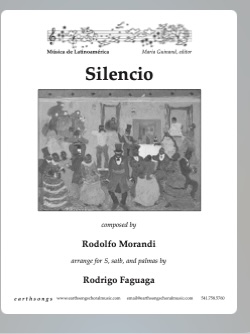Silencio (T,satb)
- Catalog ID: S-496
- First Line: Silencio, que todo el mondose calle
- Composer: Rodrigo Faguaga
- Voicing: sasa, satb
- Solo: T
- Language: Spanish
- Country: Uruguay
- Series: Musica De Latinoamerica
- Score: View Score
- Sound: Listen
Description
Text and Translation
Silencio,
que todo el mundo se calle,
que sólo se oiga en el aire
el sonido de mi voz.
Silencio,
mientras afinan los cueros,
el aire se va tiñendo
al ritmo de mi color.
Porque yo tengo
en la sangre fibra buena
y hasta la luna es morena
cuando no la mira el sol.
Porque yo tengo sabor
y soy moreno,
por eso pido silencio
que el candombe comenzó.
Se balancea furioso el tambor mayor,
la luna se sandunguea
al son del borocotó.
Se prende fuego la pollera de mi negra
y es un encanto como mueve las caderas.
Silence,
let everyone be quiet,
let it be heard in the air
the sound of my voice.
Silence,
while they refine the leathers
the air is getting colored
to the rhythm of my color
Because I have
good fiber in the blood
and even the moon is dark
when the sun doesn’t look at it.
Because I have flavor,
I am dark,
that’s why I ask for silence
that candombe began.
The drum major swings furiously,
the moon moves his hips
to the sound of the borocotó.
My black girl’s skirt catches fire, and
It’s charming how she moves her hips.
Cultural Context
Candombe is a rhythm from Africa that has been an important part of Uruguayan culture for more than two
centuries. Uruguay, with a population of approximately 3.2 million, is a small country located in South
America, bordering its two large neighbors Brazil (162 million) to the east and Argentina (34 million)
to the west. An import to Uruguay through the slave trade, candombe beats in the streets, corridors, and
carnivals of this charming little country.
At the beginning of the 19th century, the population of Africans in Montevideo exceeded 50% of the
population. The majority (≈70%) of this population has its roots in the equitorial Bantu regions of Central
and Eastern Africa with the remaining minority comprised of people from Western Africa: Guinea,
Senegal, Gambia, Sierra Leone, and the Gold Coast (modern day Ghana). Candombe is a surviving cultural
element of the Bantu heritage brought into the Río de la Plata, though the term is now a generalization for all African dances.
